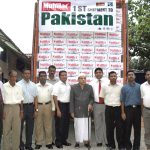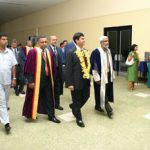
At the turn of the millennium, the “Middle East” was renowned as an astute block of sovereign nations with soaring GDP’s and glittering cities with all the trappings of the rich and the not so-famous, with wealth abundantly amassed as a result of an “eternal” supply of natural resources. Within this context, poised to take-off on a date with destiny, lay the Sultanate of Oman, bordering the Kingdom of Saudi Arabia, the United Arab Emirates, the Indian Ocean and the Gulf of Oman and the infamous gateway to the Straits of Hormuz.
By Archt Rehan Tilakaratne
Oman was indeed the new frontier waiting to be conquered by Sri Lankans.
In October 2004, Chief Architect and Proprietor Ole B. Larsen of Messer Larsen, A & CE, the architect of the prestigious Central Bank of Oman building, was once again invited by the Government of the Sultanate of Oman to be the concept and design architect for the landmark development of the Muscat International and Salalah Airport Development Project. The project, estimated at USD $ 4.0 billion (LKR 1.3Tn), was earmarked as the biggest infrastructure development in the Sultanate of Oman, in realisation of His Majesty Sultan Qaboos bin Said Al-Said’s vision to showcase Oman as the global gateway and the newly emerging tourist hotspot.
So began the journey to build two state-of-the-art, iconic airports and aerodrome complexes
With the project in hand, Mr. Larsen called upon his long time associate and confidante, Archt. Athula Ranasinghe, who had earlier worked in Oman having arrived via Saudi Arabia. Both minds, together, crafted the core team of architects to include H.B. Wijewardane arriving via Australia, Archt. J.M.R Jayasinghe via the UAE and Archt. Jayantha Perera via Sri Lanka serving in an advisory capacity. Together with COWI AS of Denmark, the COWI-Larsen JV became the architectural and engineering partners to the project.
It was a foregone conclusion that Sri Lanka was the “happy hunting ground”
The core team with its links with the University of Moratuwa, the Colombo School of Architecture and the Sri Lankan architectural fraternity, identified our island nation as the happy hunting ground for the company’s mammoth recruitment drive for the project. Armed with the decision that Sri Lankan talent would be hand-picked and a recruitment concept that revolved around keeping the core family unit together across boundaries with the provision of all “basic requirements” by the company, an HR model was adopted. This concept ensured that the team would dedicate and focus all its energy to realise the ultimate vision of constructing the two airports – an ultimate synergy.
Over the next few years the team was strengthened with the recruitment of Architects Cynthia, Melati, Piyal, Rehan, Muniratne, Mohamed Zanhar, Lal Abeyratne, Manjula Wijesekera, Mahendra W and A, Neelanga, Kithsiri, Chaminda Munasinghe, Gamini Perera, Pradeep Hewamaddumage, Chandana and Minushi, Asanga Jayasundara, Harsha and Nirmala, Rukmal, Lakkana, Ranjith Senanayake, Somanayake and a host of others from Sri Lanka. LACE thus became the foremost off-shore corporate architectural practice employing more than 35 corporate members, nine of whom were fellow members of the Sri Lanka Institute of Architects. During the pre-contract phase, a total of over 120 Sri Lankans together with over 300 other professionals from diverse backgrounds comprised the entirety of the “project team”.
It was down to the task of “getting the job done – Sri Lankan Style”
Life at LACE was ideally suited to harness the talent of the Sri Lankan diaspora; with Athula and Hemantha at the helm it was like the University days all over again – without the infamous “rag”. The entire range of the architects’ stock-in-trade was utilised in the conceptualisation of the design, which was carried-out by a core team that burnt midnight oil and worked closely together. The typical workday consisted of internal discussions, meetings with the client, stakeholders or the airport specialist, planners and the entire engineering team, for presentations, rationalisation and design justifications. Mealtimes at the office “mess” were a pleasant affair with home cooked dishes to kindle the team spirit. Come sunset, it was the time for the night owls to have a relaxing drink, a sing-song and dinner in-between brainstorming sessions recounting the design, its philosophy and plotting crucial strategies. Another tool was the interactive discussions and design workshops that were held periodically assisted by Architects Chithra, Madhura, Ranjan Gopallawa and Suchith. Together with our engineering partner, the other workshops included weekend stays at a resort hotel, focusing on team building. During the SLIA Council session 2007-2009, the President of the SLIA together with his council members participated in the all important task of “peer reviews”.
The design
The terminal buildings were dynamic, free-flowing “wave” forms depicting the notion of “flight”, but firmly anchored to the ground with podium structures. The buildings were steel structures clad with glazed curtain-walls capped with lightweight metal roofs. Traditional Omani heritage and culture were re-interpreted architecturally in the various elements used throughout the buildings. Over 50 other buildings of the aerodrome complex emulated their elder brother architecturally, but were crafted to suit their selected purpose. The Air Control Tower was the jewel in the crown, earmarked as the tallest free-standing structure in Oman.
From 2009 onwards, procured as design-build projects and implemented by five multinational construction conglomerates together with the numerous sub-consultants and specialists working on behalf of the companies, the construction work commenced at the site.
So it was the final goodbye
In 2012, “Development of Muscat International and Salalah Airports Project” was successfully completed. The transfer of knowledge and technology had evolved around the monumental effort of realising this one vision. With Lankans at the forefront, the people of the Sultanate of Oman were bestowed a legacy of committed team work, professionalism and a dedicated work ethic. The LACE team, confident and astute with a wealth of knowledge in various areas of expertise, numerous years of hands-on experience working on a mega project with a multi-disciplinary team and families in tow, enriched both financially and professionally, left Oman with fond memories of their “home away from home”. Brimming with confidence, it was a journey back to our motherland with the capacity, capability and aspiration to serve the nation, enriching both the architectural profession and the construction industry in the process.
CAD drawings: Archt Athula Ranasinghe
Architectural Firm: Larsen, A & CE
Principle Architect: Ole Boragrad Larsen
Other Consultants:
Structural, Electrical and Services Engineer: COWI A/S of Denmark
Total Area of the Site: Muscat International Airport Development Project: 45,000 acres
Salalah Airport Development Project: 29,000 acres
Foot Print:
Muscat International Airport Development Project:
Passenger Terminal Building: 3.6 million sqft
Ancillary Buildings – 0.4 million sqft
Salalah Airport Development Project
Passenger Terminal Building – 0.7 million sqft
Ancillary Buildings – 0.2 million sqft
Project Commencement: 2005
Date of Completion: Scheduled for November 2014
Contractor:
Main Contract 1(MC1) – CCC + TVA JV, MC 2 – Carillion Alawi, MC 3 – Bechtel + ENKA + BEC JV, MC4a – Towell Construction Company, MC5 – Galfar + Larsen & Toubro JV
Client: Ministry of Transport and Communication – Government of the Sultanate of Oman (MOTC), Public Authority for Civil Aviation (PACA), Oman Airport Management Company (OAMC)















